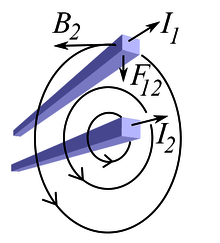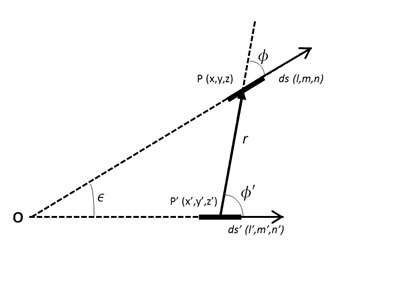Ampère's force law
| Electromagnetism |
|---|
 |
|
|

In magnetostatics, the force of attraction or repulsion between two current-carrying wires (see first figure below) is often called Ampère's force law. The physical origin of this force is that each wire generates a magnetic field, as defined by the Biot–Savart law, and the other wire experiences a magnetic force as a consequence, as defined by the Lorentz force.
Equation
The best-known and simplest example of Ampère's force law, which underlies the definition of the ampere, the SI unit of current, states that the force per unit length between two straight parallel conductors is
- ,
where kA is the magnetic force constant from the Biot–Savart law, Fm/L is the total force on either wire per unit length of the shorter (the longer is approximated as infinitely long relative to the shorter), r is the distance between the two wires, and I1, I2 are the direct currents carried by the wires.
This is a good approximation if one wire is sufficiently longer than the other that it can be approximated as infinitely long, and if the distance between the wires is small compared to their lengths (so that the one infinite-wire approximation holds), but large compared to their diameters (so that they may also be approximated as infinitely thin lines). The value of kA depends upon the system of units chosen, and the value of kA decides how large the unit of current will be. In the SI system,[1] [2]
with μ0 the magnetic constant, defined in SI units as[3][4]
Thus, in vacuum,
- the force per meter of length between two parallel conductors – spaced apart by 1 m and each carrying a current of 1 A – is exactly

The general formulation of the magnetic force for arbitrary geometries is based on iterated line integrals and combines the Biot–Savart law and Lorentz force in one equation as shown below. [5]
- ,
where
- is the total force felt by wire 1 due to wire 2 (usually measured in newtons),
- I1 and I2 are the currents running through wires 1 and 2, respectively (usually measured in amperes),
- The double line integration sums the force upon each element of wire 1 due to the magnetic field of each element of wire 2,
- and are infinitesimal vectors associated with wire 1 and wire 2 respectively (usually measured in metres); see line integral for a detailed definition,
- The vector is the unit vector pointing from the differential element on wire 2 towards the differential element on wire 1, and |r| is the distance separating these elements,
- The multiplication × is a vector cross product,
- The sign of In is relative to the orientation (for example, if points in the direction of conventional current, then I1>0).
To determine the force between wires in a material medium, the magnetic constant is replaced by the actual permeability of the medium.
Historical background

The form of Ampere's force law commonly given was derived by Maxwell and is one of several expressions consistent with the original experiments of Ampère and Gauss. The x-component of the force between two linear currents I and I’, as depicted in the adjacent diagram, was given by Ampère in 1825 and Gauss in 1833 as follows:[8]
Following Ampère, a number of scientists, including Wilhelm Weber, Rudolf Clausius, James Clerk Maxwell, Bernhard Riemann, and Walther Ritz, developed this expression to find a fundamental expression of the force. Through differentiation, it can be shown that:
- .
and also the identity:
- .
With these expressions, Ampère's force law can be expressed as:
- .
Using the identities:
- .
and
- .
Ampère's results can be expressed in the form:
- .
As Maxwell noted, terms can be added to this expression, which are derivatives of a function Q(r) and, when integrated, cancel each other out. Thus, Maxwell gave "the most general form consistent with the experimental facts" for the force on ds arising from the action of ds':[9]
- .
Q is a function of r, according to Maxwell, which "cannot be determined, without assumptions of some kind, from experiments in which the active current forms a closed circuit." Taking the function Q(r) to be of the form:
We obtain the general expression for the force exerted on ds by ds:
- .
Integrating around s' eliminates k and the original expression given by Ampère and Gauss is obtained. Thus, as far as the original Ampère experiments are concerned, the value of k has no significance. Ampère took k=-1; Gauss took k=+1, as did Grassmann and Clausius, although Clausius omitted the S component. In the non-ethereal electron theories, Weber took k=-1 and Riemann took k=+1. Ritz left k undetermined in his theory. If we take k = -1, we obtain the Ampère expression:
If we take k=+1, we obtain
Using the vector identity for the triple cross product, we may express this result as
When integrated around ds' the second term is zero, and thus we find the form of Ampère's force law given by Maxwell:
Derivation of parallel straight wire case from general formula
Start from the general formula:
- ,
Assume wire 2 is along the x-axis, and wire 1 is at y=D, z=0, parallel to the x-axis. Let be the x-coordinate of the differential element of wire 1 and wire 2, respectively. In other words, the differential element of wire 1 is at and the differential element of wire 2 is at . By properties of line integrals, and . Also,
and
Therefore the integral is
- .
Evaluating the cross-product:
- .
Next, we integrate from to :
- .
If wire 1 is also infinite, the integral diverges, because the total attractive force between two infinite parallel wires is infinity. In fact, what we really want to know is the attractive force per unit length of wire 1. Therefore, assume wire 1 has a large but finite length . Then the force vector felt by wire 1 is:
- .
As expected, the force that the wire feels is proportional to its length. The force per unit length is:
- .
The direction of the force is along the y-axis, representing wire 1 getting pulled towards wire 2 if the currents are parallel, as expected. The magnitude of the force per unit length agrees with the expression for shown above.
Famous Derivations of Ampère's Force Law
Chronologically ordered:
- Ampère's original 1823 derivation:
- Assis, André Koch Torres; Chaib, J. P. M. C; Ampère, André-Marie (2015). Ampère's electrodynamics: analysis of the meaning and evolution of Ampère's force between current elements, together with a complete translation of his masterpiece: Theory of electrodynamic phenomena, uniquely deduced from experience (PDF). Montreal: Apeiron. ISBN 978-1-987980-03-5.
- Maxwell's 1873 derivation:
- Pierre Duhem's 1892 derivation:
- Alfred O'Rahilly's 1938 derivation:
- Electromagnetic Theory: A Critical Examination of Fundamentals vol. 1, pp. 102-104 (cf. the following pages, too)
See also
References and notes
- ↑ Raymond A Serway & Jewett JW (2006). Serway's principles of physics: a calculus based text (Fourth ed.). Belmont, California: Thompson Brooks/Cole. p. 746. ISBN 0-534-49143-X.
- ↑ Paul M. S. Monk (2004). Physical chemistry: understanding our chemical world. New York: Chichester: Wiley. p. 16. ISBN 0-471-49181-0.
- ↑ BIPM definition
- ↑ "Magnetic constant". 2006 CODATA recommended values. NIST. Archived from the original on 20 August 2007. Retrieved 8 August 2007.
- ↑ The integrand of this expression appears in the official documentation regarding definition of the ampere BIPM SI Units brochure, 8th Edition, p. 105
- ↑ Tai L. Chow (2006). Introduction to electromagnetic theory: a modern perspective. Boston: Jones and Bartlett. p. 153. ISBN 0-7637-3827-1.
- ↑ Ampère's Force Law Scroll to section "Integral Equation" for formula.
- ↑ O'Rahilly, Alfred (1965). Electromagnetic Theory. Dover. p. 104. (cf. Duhem, P. (1886). "Sur la loi d'Ampère". J. Phys. Theor. Appl. 5 (1): 26–29. doi:10.1051/jphystap:01886005002601. Retrieved 2015-01-07., which appears in Duhem, Pierre Maurice Marie (1891). Leçons sur l'électricité et le magnétisme. 3. Paris: Gauthier-Villars.)
- ↑ Maxwell, James Clerk (1904). Treatise on Electricity and Magnetism. Oxford. p. 173.
External links
- Ampère's force law Includes animated graphic of the force vectors.